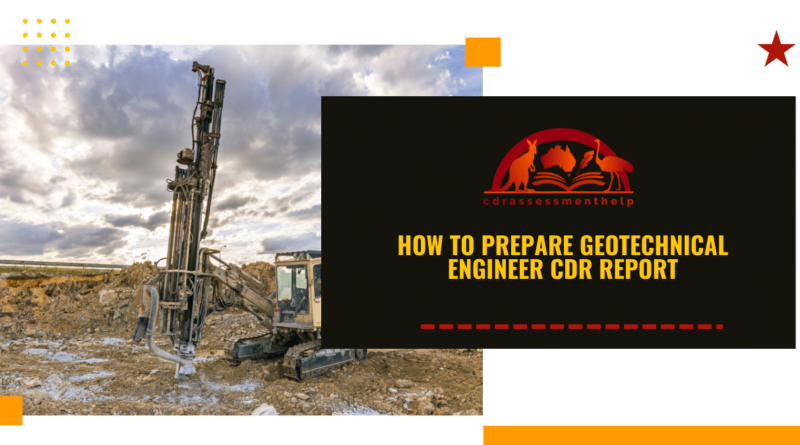Geotechnical engineering is an essential aspect
Geotechnical engineering is an essential aspect of civil engineering, and it plays a significant role in designing and constructing infrastructures. If you are a geotechnical engineer and looking to work in Australia, you need to prepare a Competency Demonstration Report (CDR) to showcase your skills and expertise to the Engineers Australia (EA) board. The EA uses the CDR to assess your engineering competency level based on Australian engineering standards.
In this article, we will guide you on how to prepare an effective CDR report that will help you get a positive assessment from EA.
Understanding the CDR Report
The CDR report is a document that describes your education, work experience, and competencies in engineering. The CDR report consists of three sections: Continuing Professional Development (CPD), Career Episodes, and Summary Statement. Here is a brief description of each section.
geotechnical Engineer CDR Report Sample: ANZSCO 233212
A geotechnical engineer works on planning, directing, and conducting the survey to examine the condition of soil and rock and carry out the appropriateness for establishing the proposed designs and structures above and below ground foundations. They explore the survey building destinations, manages plans for systems, regulate development, conduct lab tests, and carry out the effectiveness of the reports.
Geotechnical engineers which falls under the occupation group ANZSCO 233212 looking forward to migrating and building a better career path in Australia must prepare a CDR report under the Engineers Australia Migration Skills booklet. As one of the renowned CDR service providers, CDR Assessment Help offer our clients high-quality CDR reports created by our skilled CDR writers. We have plenty of CDR sample reports for engineering students on our website. Kindly use the available samples as a reference and avoid copying the materials for plagiarism-free content.
Continuing Professional Development (CPD)
In the CPD section, you need to list your formal and informal engineering-related training courses, workshops, and seminars that you have attended in the last three years. You should also provide a detailed summary of the skills and knowledge that you have gained from those activities.
Career Episodes
Career Episodes are the most crucial part of the CDR report. In this section, you need to describe three engineering projects you have worked on in detail. You should describe your role in each project, the challenges you faced, the actions you took to overcome those challenges, and the results you achieved.
Summary Statement
The Summary Statement is a brief summary of the engineering competencies that you have demonstrated in your Career Episodes. You need to cross-reference your claims in the Career Episodes with the Engineers Australia (EA) competencies to demonstrate your proficiency level.
Writing Style
It is essential to use a formal writing style while preparing the CDR report. Avoid using jargon and technical terms that are not familiar to the EA assessors. You should also follow the Australian English writing style and grammar. The report should be concise, clear, and easy to understand.
How to Prepare the CDR Report
Here is a step-by-step guide on how to prepare the CDR report.
Step 1: Choose Three Career Episodes
Choose three career episodes that best demonstrate your engineering competency. Ensure that they align with the Australian Engineering Standard.
Step 2: Write a CPD
List all the training, workshops, and seminars that you have attended in the last three years in the CPD section. Provide a summary of the skills and knowledge that you have gained from those activities.
Step 3: Write Career Episodes
In each Career Episode, write a detailed description of your engineering projects. Follow the format below:
Introduction
Provide a brief overview of the project, your role, and the organization you worked for.
Background
Describe the background of the project, the engineering problems, and the scope of your work.
Engineering Activities
Describe the engineering activities that you performed in the project, the tools and techniques you used, and the results you achieved.
Personal Engineering Activities
In this section, describe your specific role in the project, the challenges you faced, the actions you took to overcome those challenges, and the results you achieved.
Step 4: Write a Summary Statement
In the Summary Statement, cross-reference the competencies you have demonstrated in your Career Episodes with the Engineers Australia (EA) competencies. Provide evidence to support your claims.
Conclusion
Preparing a CDR report is a challenging task that requires attention to detail and precision. By following the steps outlined in this article, you can prepare an effective CDR report that showcases your engineering competencies to the Engineers Australia (EA) board.
FAQs
- What is the Engineers Australia (EA) Competency Standard?
The EA Competency Standard is a set of guidelines that assesses the engineering competencies of engineers who want to work in Australia. It outlines the knowledge, skills, and attributes that an engineer must demonstrate to practice engineering in Australia.
- How many Career Episodes do I need to include in my CDR report?
You need to include three Career Episodes in your CDR report. Each Career Episode should describe a specific engineering project that you have worked on.
- How long should my CDR report be?
There is no specific word limit for the CDR report. However, it is recommended that you keep the report concise and clear. The report should be long enough to demonstrate your engineering competencies and skills.
- How long should each Career Episode be?
Each Career Episode should be between 1,000 to 2,500 words. The length of each episode depends on the complexity of the project and the details you need to provide to demonstrate your engineering competency.
- How long should the Summary Statement be?
The Summary Statement should be around one page long. In this section, you need to cross-reference the competencies you have demonstrated in your Career Episodes with the Engineers Australia (EA) competencies. Provide evidence to support your claims.



